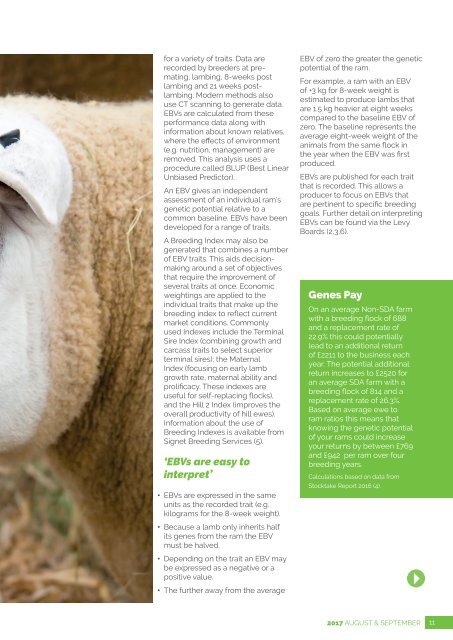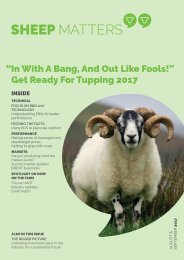Sheep Matters_Aug-Sept 17 (redesigned)
Sample copy of new publication aimed at the progressive farmer and professional in the UK sheep industry. For further information and to register your interest go to www.sheepmatters.co.uk
Sample copy of new publication aimed at the progressive farmer and professional in the UK sheep industry. For further information and to register your interest go to www.sheepmatters.co.uk
You also want an ePaper? Increase the reach of your titles
YUMPU automatically turns print PDFs into web optimized ePapers that Google loves.
for a variety of traits. Data are<br />
recorded by breeders at premating,<br />
lambing, 8-weeks post<br />
lambing and 21 weeks postlambing.<br />
Modern methods also<br />
use CT scanning to generate data.<br />
EBVs are calculated from these<br />
performance data along with<br />
information about known relatives,<br />
where the effects of environment<br />
(e.g. nutrition, management) are<br />
removed. This analysis uses a<br />
procedure called BLUP (Best Linear<br />
Unbiased Predictor).<br />
An EBV gives an independent<br />
assessment of an individual ram’s<br />
genetic potential relative to a<br />
common baseline. EBVs have been<br />
developed for a range of traits.<br />
A Breeding Index may also be<br />
generated that combines a number<br />
of EBV traits. This aids decisionmaking<br />
around a set of objectives<br />
that require the improvement of<br />
several traits at once. Economic<br />
weightings are applied to the<br />
individual traits that make up the<br />
breeding index to reflect current<br />
market conditions. Commonly<br />
used Indexes include the Terminal<br />
Sire Index (combining growth and<br />
carcass traits to select superior<br />
terminal sires); the Maternal<br />
Index (focusing on early lamb<br />
growth rate, maternal ability and<br />
prolificacy. These indexes are<br />
useful for self-replacing flocks),<br />
and the Hill 2 Index (improves the<br />
overall productivity of hill ewes).<br />
Information about the use of<br />
Breeding Indexes is available from<br />
Signet Breeding Services (5).<br />
‘EBVs are easy to<br />
interpret’<br />
• ●EBVs are expressed in the same<br />
units as the recorded trait (e.g.<br />
kilograms for the 8-week weight).<br />
EBV of zero the greater the genetic<br />
potential of the ram.<br />
For example, a ram with an EBV<br />
of +3 kg for 8-week weight is<br />
estimated to produce lambs that<br />
are 1.5 kg heavier at eight weeks<br />
compared to the baseline EBV of<br />
zero. The baseline represents the<br />
average eight-week weight of the<br />
animals from the same flock in<br />
the year when the EBV was first<br />
produced.<br />
EBVs are published for each trait<br />
that is recorded. This allows a<br />
producer to focus on EBVs that<br />
are pertinent to specific breeding<br />
goals. Further detail on interpreting<br />
EBVs can be found via the Levy<br />
Boards (2,3,6).<br />
Genes Pay<br />
On an average Non-SDA farm<br />
with a breeding flock of 688<br />
and a replacement rate of<br />
22.9% this could potentially<br />
lead to an additional return<br />
of £2211 to the business each<br />
year. The potential additional<br />
return increases to £2520 for<br />
an average SDA farm with a<br />
breeding flock of 814 and a<br />
replacement rate of 26.3%.<br />
Based on average ewe to<br />
ram ratios this means that<br />
knowing the genetic potential<br />
of your rams could increase<br />
your returns by between £769<br />
and £942 per ram over four<br />
breeding years.<br />
Calculations based on data from<br />
Stocktake Report 2016 (4).<br />
• ●Because a lamb only inherits half<br />
its genes from the ram the EBV<br />
must be halved.<br />
• ●Depending on the trait an EBV may<br />
be expressed as a negative or a<br />
positive value.<br />
• ●The further away from the average<br />
Q<br />
20<strong>17</strong> AUGUST & SEPTEMBER 11



